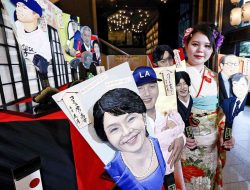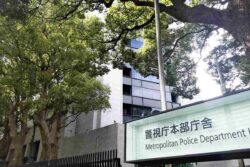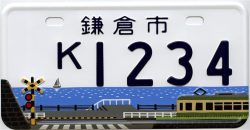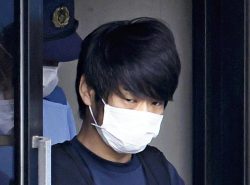
The Ground Self-Defense Force’s AAV7 amphibious assault vehicles conduct a landing drill on Nov. 18 at Manda beach in Tokunoshima, Kagoshima Prefecture.
2:00 JST, December 13, 2022
This is the second part of the first installment in a series that will monitor ongoing international developments and identify necessary tasks if Japan were to become embroiled in a contingency. This will involve putting a spotlight on the Self-Defense Forces, which play a fundamental role in Japan’s defense; the defense industries and the Japan Coast Guard, which jointly support national security along with the SDF; and measures to protect the public in the event of a national emergency.
***
The “Keen Sword 23” Japan-U.S. joint military exercise, which was conducted mainly on islands in Kagoshima and Okinawa prefectures, focused on joint operation planning between the Self-Defense Forces and the U.S. military.
“We found an enemy ship approaching.”
On the afternoon of Nov. 16, the atmosphere became tense when the first report was delivered to a Japan-U.S. coordination office set up in a conference room of the Ground Self-Defense Force’s Camp Amami on Amami-Oshima island in Kagoshima Prefecture. SDF members and U.S. military personnel immediately started to make a plan to prevent the enemy from landing.
The coordination office, overseen by a GSDF colonel and a U.S. Marine Corps colonel, was staffed with about 40 personnel, who were divided into teams responsible for different tasks, such as “information,” “operations,” “logistics” and “medical.” The GSDF’s Type 12 surface-to-ship guided missile and the U.S. Marine Corps’ High Mobility Artillery Rocket System (HIMARS) would be used to attack the enemy ship. Based on the location identified by the information team, the operations team gave an attack order.
Japan-U.S. military exercises that involve setting up a coordination office have been limited, such as Keen Sword and the Resolute Dragon exercise held in Hokkaido. A senior SDF officer said they are among the few occasions when the SDF and the U.S. military can be on the same page to tackle various challenges from information gathering and analysis to operation planning and implementation. In the latest exercise, they set up coordination offices in Naha and on Yonaguni Island in Okinawa Prefecture on the premise that multiple remote islands were simultaneously invaded.
An SDF member who participated in the exercise emphasized its significance, saying, “I learned quite a lot, such as the speediness of making attack decisions based on a variety of information.”
On Nov. 14, when the Keen Sword 23 reached its halfway point, Gen. Koji Yamazaki, chief of staff of the SDF’s Joint Staff, and Lt. Gen. Ricky Rupp, commander of U.S. Forces Japan, landed on the deck of the MSDF vessel Izumo as it traveled in the Pacific Ocean off Kagoshima Prefecture.
At a joint press conference aboard the ship, Yamazaki said, “Based on the Japan-U.S. Alliance, which is the strongest ever, the SDF and the U.S. military work as one in conducting each and every exercise.”
“There are those who remain determined, and not slowing in their intents to unilaterally dismantle peace,” Rupp said apparently with China in mind. “So if ever our mutual safety and peaceful way of life is contested, we stand ready to uphold our duty of mutual defense.”
Then, Yamazaki and Rupp firmly shook hands.
Double role
Responding to the increasingly difficult security environment, the Japan-U.S. alliance has become stronger year by year, even while there are many issues to be addressed. One of them involves the SDF’s organizational structure.
On Oct. 4, when a missile launched by North Korea passed over Aomori Prefecture, Yamazaki discussed responses to the incident with visiting U.S. Indo-Pacific Command chief Adm. John Aquilino at the Defense Ministry and told him, “I would like to closely coordinate with you, [as you are] the command chief and my U.S. counterpart.”
Since Japan’s chief of staff is the top SDF officer, it would seem that their U.S. counterpart should be the chairman of the U.S. Joint Chiefs of Staff, who is the top U.S. uniformed officer. However, the primary role of the chairman of the Joint Chiefs is to provide military advice to the president, who is the commander in chief of the U.S. military, and to the defense secretary, while the chairman does not exercise military command.
In contrast, Japan’s chief of staff not only provides advice on how to operate SDF units for the prime minister and the defense minister but also oversees the operations of the Ground, Maritime and Air Self-Defense Forces.
In that light, Aquilino, who commands the operations of U.S. forces in the Indo-Pacific region, is one de facto counterpart of Yamazaki, but Gen. Mark Milley, the chairman of the Joint Chiefs, is another. Yamazaki currently has to play a “double role,” making it difficult for him to perform his duties in parallel with responses to possible contingencies.
Adm. Harry Harris, who served as a commander of the U.S. Pacific Command (now the U.S. Indo-Pacific Command) from 2015 to 2018, told then Japan Chief of Staff Adm. Katsutoshi Kawano that, since Kawano’s counterpart should be the chairman of the Joint Chiefs, Harris himself had no counterpart in Japan.
If Japan creates a joint command to manage the operations of the Self-Defense Forces and a new commanding officer position to head the command, the officer in that position would be the counterpart of the U.S. Indo-Pacific Command chief. This would allow Japan to avoid slow responses to contingencies and coordinate with the U.S. military more closely. In preparation for a possible Taiwan contingency, the government is moving to create a new joint command and a new commanding officer position.
Firing live ammunition
To enhance Japan-U.S. cooperation and coordination, it is also important for both countries to increase firing exercises with live ammunition as it creates an environment similar to actual fighting. However, during Keen Sword 23, such exercises were conducted only by a small number of participants.
In Japan, missiles and other weapons with a range of over 10 kilometers can be launched only from the Yausubetsu training area in Hokkaido. It is not unusual for companies to go a whole year without firing actual ammunition. Type 12 surface-to-ship guided missiles will be the mainstay of counterattack capabilities to defend remote islands but they cannot be launched in and around the Sea of Japan due to constraints related to fishing rights. In effect, SDF personnel can only use live ammunition outside Japan.
“There are many experiences that can be gained only by exercises with live ammunition, such as [dealing with] the direction of the wind and the weather,” Kawano said. “Conducting many Japan-U.S. joint exercises will help both sides increase trust in each other’s equipment.” It is necessary to increase such opportunities by holding more joint exercises for firing with live ammunition in the United States and making arrangements with fishermen and relevant municipalities under the initiative of the Japanese government to enable live-fire exercises in Japan.
To enhance deterrence, Japan should show, both domestically and internationally, its resolve and determination to defend its territories and make continuous efforts to make the relations of mutual trust with the United States the best possible.
"Politics" POPULAR ARTICLE
-

Japan to Charge Foreigners More for Residence Permits, Looking to Align with Western Countries
-
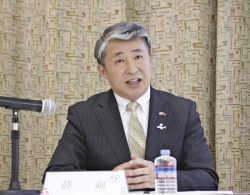
China Would Cut Off Takaichi’s ‘Filthy Head’ in Taiwan Crisis, Diplomat Allegedly Says in Online Post
-
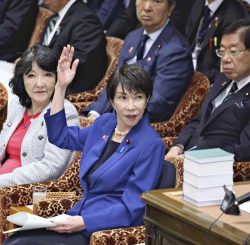
If China Were to Impose Blockade on Taiwan, Existential Crisis Could Be Triggered, Japan’s Prime Minister Takaichi Says
-

Japan to Tighten Screening of Foreigners’ Residential Status by Providing Information of Nonpayment of Taxes
-

Takaichi Cabinet Approval Holds at 72% as Voters Back Aggressive Fiscal Stimulus, Child Benefits
JN ACCESS RANKING
-

Govt Plans to Urge Municipalities to Help Residents Cope with Rising Prices
-

Japan Resumes Scallop Exports to China
-

Japan Prime Minister Takaichi Vows to Have Country Exit Deflation, Closely Monitor Economic Indicators
-

Japan to Charge Foreigners More for Residence Permits, Looking to Align with Western Countries
-

JR East Suica’s Penguin to Retire at End of FY2026; Baton to be Passed to New Character






